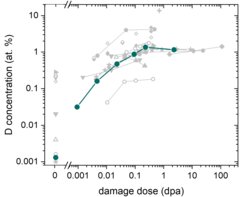Detection of minute defects in tungsten
Experimental method provides important data on the generation of radiation damage in tungsten

A fusion reactor must breed at least as much tritium as is required to maintain the fusion reactions. The tritium absorption of the first wall of the reactor must therefore be kept low. As a wall material, tungsten fulfills this requirement because the solubility of hydrogen isotopes in the tungsten crystal lattice is low. However, the neutron bombardment creates lattice defects that can trap hydrogen isotopes. The scientific investigation of this effect has so far been hampered by the fact that such defects can hardly be quantified experimentally. This difficulty has now been overcome at IPP using a new experimental strategy: Damage to the lattice is not caused by neutrons, but by irradiation with 20 MeV tungsten ions at the IPP tandem accelerator. The defects are marked in a controlled manner with deuterium in a low-temperature plasma and then quantified using nuclear reaction analysis at the accelerator. This was used to determine the defect density as a function of the irradiation dose measured in "dpa" (displacements per atom). The initial almost linear increase in retention with the irradiation dose saturates at very low values of 0.1 dpa (Fig). Based on these data, solid predictions can now be made about the tritium inventory of future fusion reactors.
T. Schwarz-Selinger: “A Critical Review of Experiments on Deuterium Retention in Displacement-Damaged Tungsten as Function of Damaging Dose.” Materials Research Express 10, (2023): 102002.
https://doi.org/10.1088/2053-1591/acfdf8
